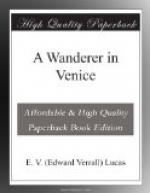Across the road is a Scuola with ceilings by the dashing Tiepolo—very free and luminous, with a glow that brought to my mind certain little pastorals by Karel du Jardin, of all people!
It is now necessary to get to the Campo di S. Barnaba, where under an arch a constant stream of people will be seen, making for the iron bridge of the Accademia, and into this stream you will naturally be absorbed; and to find this campo you turn at once into the great campo of S. Margherita, leaving on your left an ancient building that is now a cinema and bearing to the right until you reach a canal. Cross the canal, turn to the left, and the Campo di S. Barnaba, with its archway under the houses, is before you.
The direct way from S. Sebastiano to this same point and the iron bridge is by the long Calle Avogadro and Calle Lunga running straight from the bridge before the church. There is no turning.
The Calle Lunga is the chief shopping centre of this neighbourhood—its Merceria—and all the needs of poorer Venetian life are supplied there. But what most interested me was the death-notices in the shop windows. Every day there was a new one; sometimes two. These intimations of mortality are printed in a copper-plate type on large sheets of paper, usually with black edges and often with a portrait. They begin with records as to death, disease, and age, and pass on to eulogise the departed. It is the encomiastic mood that makes them so charming. If they mourn a man, he was the most generous, most punctilious, and most respected of Venetian citizens. His word was inviolable; as a husband and father he was something a little more than perfection, and his sorrowing and desolate widow and his eight children, two of them the merest bambini, will have the greatest difficulty in dragging through the tedious hours that must intervene before they are reunited to him in the paradise which his presence is now adorning. If they mourn a woman, she was a miracle of fortitude and piety, and nothing can ever efface her memory and no one take her place. “Ohe!” if only she had been spared, but death comes to all.
The composition is florid and emotional, with frequent exclamations of grief, and the intimations of mortality are so thorough and convincing that one has a feeling that many a death-bed would be alleviated if the dying man could hear what was to be printed about him.
After reading several one comes to the conclusion that a single author is responsible for many; and it may be a Venetian profession to write them. A good profession too, for they carry much comfort on their wings. Every one stops to read them, and I saw no cynical smile on any face.
CHAPTER XXVII
CHURCHES HERE AND THERE
S. Maria dei Miracoli—An exquisite casket—S. Maria Formosa—Pictures of old Venice—The Misericordia—Tintoretto’s house—The Madonna dell’Orto—Tintoretto’s “Presentation”—“The Last Judgment”—A Bellini—Titian’s “Tobias”—S. Giobbe—Il Moro—Venetian by-ways—A few minor beauties.




